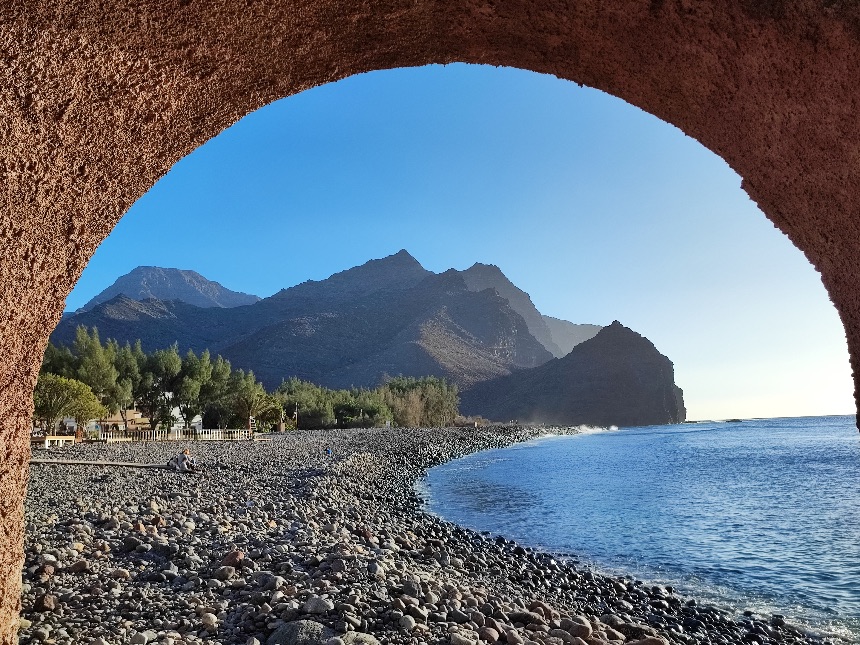From Volcanoes to Beaches - Discover Lanzarote's Most Beautiful Sights
A unique volcanic landscape, light and dark beaches, and the art of César Manrique
*Promotion*

Lanzarote - what a unique Island
With its area of 862 square kilometers, Lanzarote is the fourth largest Canary Island and only 130 km from the African mainland. The unique volcanic landscape of this brittle island is one of its many attractions. I looked at some of them in June 2023 and was (once again) thrilled by Lanzarote.

On tour with Cristina
Puerto del Carmen, Playa Blanca, and Costa Teguise are the most popular holiday resorts on the island, mainly because of their beaches. However, it would be a shame not to see the magnificent nature of Lanzarote. All the sights are relatively easy to reach due to the size of the island and the well-maintained roads. I explored the hotspots by rental car from my domicile Secrets Lanzarote Resort & Spa in the south of the island and the Arrecife Gran Hotel & Spa in the capital Arrecife. During some of my excursions, I had Cristina Gónzalez at my side. The young photographer and her partner Cristian take impressive pictures of "her" island. I got on well with Cristina right away - and apart from the beautiful photos, I learned a lot about Lanzarote through her. I present my highlights below, from south to north.

Playa de Papagayo - my favourite beach
Papagayo is the most beautiful beach on the island, or more precisely, there are seven. Located in the middle of a nature reserve, the beaches, separated by small mountains, shimmer golden yellow.

The water temperature was enjoyable these June days, and I didn't want to leave the sea. La vida es chula - life is wonderful! Before midday, the beach was not very crowded - so it's best to go to Playa Papagayo in the morning. Tip: Make sure you climb the hill to enjoy the view over all the bays. Great photos are guaranteed! You can even see the neighbouring islands of Lobos and Fuerteventura. Very important: Take provisions, water, and sufficient sun protection (preferably also a cap). The beach has almost no infrastructure and can get quite hot during the day. On the way to Playa de Papagayo, it is worth making a photo stop in the village of Femés with its "mirador," a lookout point with a view over the mountains and the sea.

Chilling out in Puerto Calero
The seaside resort of Playa Blanca in the south (from here, the ferry goes to Corralejo on Fuerteventura) has become very touristy for me. More charming is the relatively new little marina Puerto Calero with its elegant fashion mile and nice cafés and restaurants right on the water.

Timanfaya National Park
The drive through the spectacular lunar landscape is a must. Suppose you want to visit the fire mountains ("montañas del Fuego"). In that case, you must change to a bus at Islote de Hilario (unfortunately...) to continue the tour through the volcanic landscape to the restaurant El Diabolo. Just a few meters below this restaurant, considered the most unusual in Spain, is a lava pool with a temperature of 400 degrees Celsius. On the natural grill above the hole, meat, fish, and potatoes are roasted without electricity or gas; what a spectacle!

You can also explore Timanfaya National Park on camelback. Even though desert animals are considered to be very hard-wearing - my thing is not when they often transport heavyweight tourists over the mountains.
The legend of the little devil "el diabolo"
The extraordinary volcanic landscape results from six years of volcanic eruptions from 1730 to 1736, and a 1996 César Manrique devil as the park's mascot (Instagram!) symbolizes the hell of the past transformed into a scenic wonder. "There is a legend about a pair of lovers in the 18th century," Cristina tells me. "The two of them wanted to get married with a pompous celebration. When the ceremony was in full swing, the earth began to shake. The volcano exploded. A boulder buried the bride. The groom grabbed a pentagon to free his bride. He could only retrieve her dead. In desperation, he stretched the Pentagon above his head and shouted. "The poor devil," whispered the surviving villagers. That's how the little devil came to be the symbol of the island."

Yaiza - what a pretty village
There are some very neat white villages on Lanzarote. Yaiza, very close to Timanfaya National Park, particularly appealed to me. Magnificent flame trees and buganvillas form an excellent contrast to the white of the little houses. In the Casa de la Cultura, built in the 19th century, you can enjoy various exhibitions and a delicious smoothie or "café solo" on the pleasantly fresh patio.

Charming Teguise
The former capital of Lanzarote is located almost in the center of the island. It is another must-visit with its historic center. However, the much-praised Sunday market was too crowdy and touristy for me. A stroll through the alleys with their numerous pretty boutiques and cafés is more interesting. In one of the local shops, I picked up a bracelet made of lava stones and a ring with the little fire devil, the symbol of Lanzarote - nice souvenirs! Tip: Treat yourself to a refreshment in La Galeria, a pretty tapas bar with a terrace (not far from the evident parish church) and the meaningful nickname "Soul Kitchen." The bar is open Tuesdays to Saturdays from 12 to 17, and Sundays from 10 to 24.


On the way from Arrecife to Teguise, you will inevitably come across bizarre rock formations on the side of the road on the LZ-404, which are impossible to miss. A short photo stop is worthwhile. The rocks called "Stratified City" almost look like the backdrop of a science fiction film. They regularly change their appearance due to erosion.

Surprise in Arrieta
On the way north, it is worth making a photo stop in the fishing village of Arrieta, which is very close to beautiful beaches. Here you can enjoy typical Canarian life away from the tourist resorts. The highlight is the Asian-style "Casa Azul", which stands out wonderfully against the white houses with its blue façade (excellent Instagram motif!). "The Casa was built in 1920 by an islander for his daughter, who had lung disease so that she could recover by the sea," Cristina tells me. "In 1995, it became the Centro de Arte y Cultura Africana, but only lasted two years." Today, the house belongs to a wealthy family but is empty. Both the home and the small garden are in immaculate condition, however.

Jardin de Cactus and Jameos del Agua - two masterpieces by César Manrique
From Arrieta and the neighboring village of Punta Mujeres, it is close to the impressive Jameos del Agua cave. On the way, it is worth stopping at the Jardin de Cactus, a fantastic collection of around 450 different species of cacti. This is the last work of the world-famous local artist César Manrique, whom I will discuss later. The cactus garden blends wonderfully into the bizarre landscape of Lanzarote.

Jameos del Agua is a unique cave formed by geological formations with a lagoon. Numerous endemic, blind little crabs live here, which can be easily seen with the naked eye. The aforementioned César Manrique developed this place into a tourist attraction with a natural concert hall during his lifetime - despite the crowds, absolutely worth seeing and not to be missed!

Cueva de los Verdes
I visited this cave - part of a volcanic tunnel whose passage extends to the mouth of the sea - many years ago. Unfortunately, I didn't have the time, but there will undoubtedly be a next time!
Breathtaking view at the Mirador del Río
This viewpoint on the 474-meter-high Risco de Famara is the highlight of Lanzarote for me. The view of the increasingly popular neighboring island of La Graciosa, which can be reached by a small ferry from Orzola on Lanzarote, takes your breath away. The viewpoint with the restaurant, built by César Manrique into a rock relief, is almost always well-frequented - no wonder. If you want it to be quieter, turn left onto a path a few meters before it. You can enjoy the breathtaking panorama at your leisure and experience almost meditative moments here. "Once a year, Cristian and I spend a few relaxing days on La Graciosa, which is now officially the eighth island of the Canaries," says Cristina. "There are no asphalted roads there - but that's what makes La Graciosa so charming." I have to go there too!

Haria and Famara
From the Mirador del Río, we continue towards Famara. I've already heard much about the impressive beaches and mountain scenery and can hardly wait. To our great disappointment, the spectacular Mirador del Balcón viewpoint is closed on this day due to a public holiday. As a "content creator," I would have loved to take a photo here. We drive a few kilometers further to the Mirador de Haria - not quite as photogenic, but still great for a few shots.

Haria is also known as the village of a thousand palm trees. "Haria is shaped like a witch, look," Cristina tells me. With a bit of imagination, I recognize the "brujita", which is supposed to be even more visible at night with the lights of Haria. https://www.lanzarote.com/de/lanzarote-entdecken/geheime-ecken/die-hexe-von-haria/

After a short drive through spectacular scenery, we reach the coastal town of Famara. It is time for lunch. The restaurants directly by the sea are packed this Saturday, but we find a place in the second row of the beach. For 23 EUR (but without wine), we enjoy simple but good specialties like the famous "papas arrugadas" (shrunken potatoes with two spicy sauces), a delicious salad, and a Spanish tortilla (potato omelet). I'm thrilled at how friendly the staff is, scurrying back and forth despite the large crowd - chapeau!
Popcorn on the Beach
After the refreshment, we go to the so-called popcorn beach. The tiny fossilized algae look like popcorn. From here, the view goes over the 6-kilometer-long bay to the bizarre Famara massif. There is also the 671-meter-high Peñas del Chace, which is a restricted military area. Famara is not only a paradise for sun worshippers but also for surfers. The ambiance in the village is correspondingly casual and relaxed. I could easily spend a few days here just hanging out.

Lots of wine in La Geria
The end of our spectacular tour is the wine-growing area around the village of La Geria. Wine on a barren island like Lanzarote? YES! On the island, resourceful farmers have developed a system that is unique in the world. Holes several meters deep are dug in the volcanic gravel, in the middle of which the vines are planted. The edges are protected from the wind by a crescent of stones. The view of the vineyard in this barren region is quite spectacular. No wonder Lanzarote has been declared a biosphere reserve by UNESCO. By the way, the wine from Lanzarote (Malvasia) tastes excellent - whether white or red. You can taste the fine wines with tapas in one of the many bodegas and take home a nice souvenir.

Arrecife
You can find (almost) everything you need to know about the small island capital of Lanzarote in my article about the Arrecife Gran Hotel & Spa.

César Manrique
Lanzarote owes a lot to this gifted artist, who died in a car accident in 1996. Manrique already had a vision of sustainability and environmental protection in the 70s. He understood, like no other, how to combine art and nature. The many monuments on Lanzarote, such as the Jameos del Agua cave, are beautiful examples. In a series of volcanic bubbles, his house has become a landmark on Lanzarote. It offers the best opportunity to learn more about the exceptional artist born in Arrecife.

In my living room hangs an abstract artwork by the great master, with a personal dedication ("Para Carlos con todo mi afecto" - for Karl-Heinz with all my affection"). It was given to me by a hotelier in the late 80s when I worked as a hotel buyer on Lanzarote, among other places. What a treasure!
How can I reach the sights of Lanzarote?
Lanzarote has a modern airport only about 8 kilometres from the capital Arrecife. Almost 40 airlines will take you from many European airports to the island in approximately four hours. You will find more information about air access here.


On Lanzarote, a rental car is best and much cheaper than some people think. I paid 150 EUR for one week, including comprehensive insurance - which wasn't the most reasonable offer. The roads to most sights are well-maintained and relatively easy to drive. Have a look here.

Alternatively, there are good bus connections on Lanzarote, and you can find prices and times on the page of Arrecife Bus. Of course, you can also book organised excursions through your hotel or via Get your Guide.

Climate and weather on Lanzarote
Lanzarote is a year-round destination. The temperature fluctuations between summer and winter are relatively small. You can expect bathing weather at up to 29 degrees Celsius in summer. It is often over 20 degrees Celsius in January, and the sun shines most of the time. Winter is ideal for hikers and cyclists, while in summer, most tourists come to Lanzarote for (sun)bathing.

Accommodation on Lanzarote
During my one-week stay in June 2023, I enjoyed these two hotels:
Secrets Lanzarote Resort & Spa, a chic five-star adults-only hotel in Puerto Calero.

Arrecife Gran Hotel & Spa, a luxurious beach hotel in the middle of the capital Arrecife.
*My blog readers get a discount on bookings!*

Of course, there are also cheaper accommodations; the best is to look on the website of Turismo Lanzarote.
My summary
With its volcanic landscapes, Lanzarote is a very unique island. It also offers fantastic sandy beaches and lots of water sports. The island is a paradise for bikers and hikers. I particularly loved the many clean, white villages. In short - Lanzarote is an island worth to explore.
You wish to see more of the Canary Islands? Have a look at my articles about Fuerteventura and Gran Canaria.




